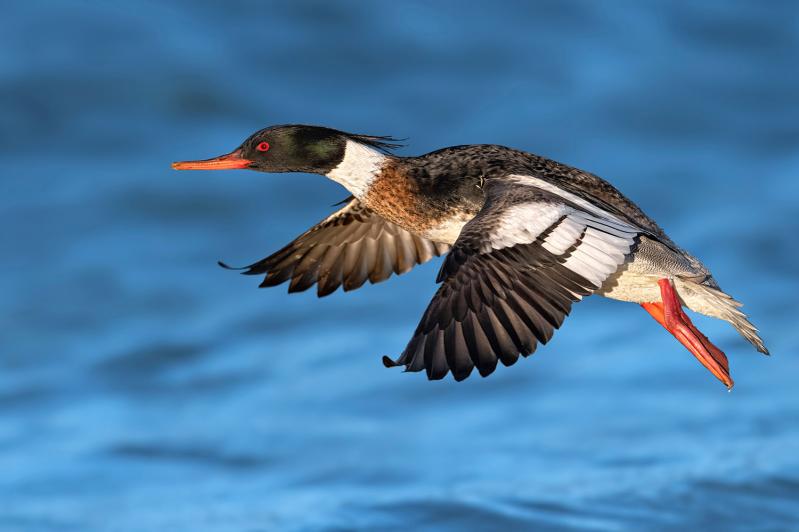On a windless morning last week I stood atop a bluff overlooking Northwest Harbor, the morning sun turning parts of the bay bright with reflection, and watched five red-breasted mergansers, two males with three females, fish.
Staving off my compulsion to keep moving, to continue the loop I was walking, I entered merganser time, and left only when they left, 30 minutes later.
The fact that the mergansers were present was no surprise. They rely on the open waters of our winter bays and harbors from November until April. It was the view that caught me. From the vantage point of the cliff, I was able to look down into the still water. I could have counted the billions of submerged thumb-size rocks. Instead, I watched the mergansers hunt.
In the winter of 1941, the legendary East End naturalist William Tod Helmuth counted 40,000 red-breasted mergansers between East Hampton and Montauk.
Mr. Helmuth also found a red-breasted merganser nest on Oyster Pond in Montauk, although those were different times. If they breed in New York anymore, it’s only in the far north, along the western boundary.
So, winter is the best time to see these ducks. They’ll be there if you walk anywhere along the bay side of the South Fork, between Southampton and Montauk. While they prefer salt water, they also frequent Hook Pond, Sagaponack Pond, and Georgica Pond.
From the 80-foot bluff, I looked across at Mashomack Point, directly across the bay from Barcelona Point. The invisible line connecting the two creates a rough border separating Northwest Harbor and its undulating shoreline to the east from Sag Harbor Bay and the built eastern shore of North Haven to the west.
(Barcelona Point itself was nearly developed, before a citizen campaign in the late 1980s helped create the awareness needed to pressure the state to purchase the 341 acres.)
Two miles north, on a spit of sand jutting out into Northwest Harbor, sits the partially restored Cedar Point Lighthouse. Two miles south, the sound of a truck’s jake brake growled on Route 114.
The five red-breasted mergansers flew in, sleek and slender, flashing white wing patches, and landed in the water just below me, where the golden bluff meets the bay.
The orange eye of the male red-breasted merganser stands out on its mallard green head, which, due to its rakish and spiky do, appears to be in a perpetual wind tunnel. The female is overcast-colored with a cinnamon head and white throat.
They share a thin bill featuring serrated edges, which give the ducks one of their nicknames: sawbill. Another moniker, sheldrake, is still used by old-time hunters.
Who knows why they were ever hunted, certainly not for food.
A post on elevatedwild.com cautioned that cooking one will make your house smell of fish for days. “If you cook merganser like you would any other duck, it is pretty terrible,” writes the author before concluding that the only way to eat this bird was to make merganser jerky — a culinary treat I can’t see catching on any time soon.
It’s the sawbill that allows it to capture and hold the slippery little fish that comprise its diet.
In fact, according to allaboutbirds.org, a merganser must eat 15 to 20 fish per day, which requires approximately 250 to 300 daily dives. All told, these birds fish four to five hours daily.
Underwater, in pursuit of minnows, the mergansers sometimes chased each other, and I noticed a thought enter my head: They looked like they were playing, or having fun. Odds are, they were locked in some merganser death battle. Nature is hard.
Red-breasted mergansers are largely silent. I’ve never heard one vocalize. The only sounds they made that morning were water sounds, splashing when they dived, dripping when they surfaced.
They’re a quiet bird for a relatively quiet time of year. Like the other bay ducks of the winter, the long-tailed duck, the scoters, and the goldeneye, they provide the water a personality that is wild and lacking in summer when it’s cluttered by boats and human ego.
The mergansers worked the shallows until out of sight, heading toward Northwest Landing County Park and a common loon, lethargic and slow compared to the zippy mergansers.
In the 30 minutes I had watched them, the distance from the water to the wrack line had grown, as had the low-tide rocks. I had been staring so long at the water that when I stepped back onto the trail, I had blue bay dots in my eyes when I blinked.

